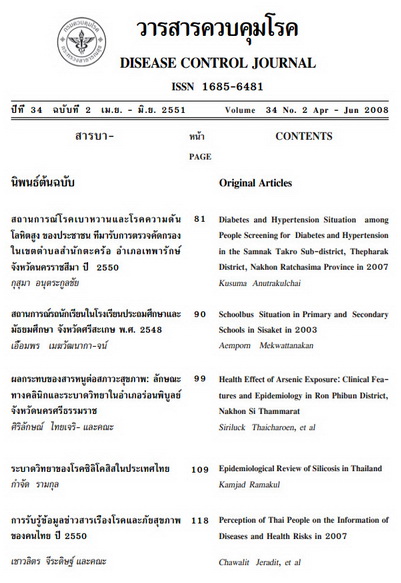Epidemiological Review of Silicosis in Thailand
Keywords:
Epidemiology of Silicosis, ThailandAbstract
Silicosis was firstly found in Thailand in 1954. Occupational exposure to silica dust was a significant contributor to the disease. However, limited data was avialable about the disease distribution and specific job types that might pose higher risk to Thai workers. The main objective of this study was to review the prevalence rate and distribution of Silicosis as well as high risk occupations and the disease surveillance system in Thailand. A document review and data analysis was performed using existing databases from the National Health Security Office (NHSO) and selected provinces that had high risk enterprises and implemented active silicosis surveillance program. It was found that 43 silicosis cases from 20 provinces and 30 cases from 17 provinces were hospitalized and reported to the NHSO in 2006 and 2007 respectively. The prevalence rate of suspected and probable Silicosis cases (defined by the ILO X-Ray classification as profusion level of 0/1 and 1/0) identifying from 3 selected provinces was 44.8% 2006 and 11.6% in 2007, whereas the definite Silicosis cases (Profusion level 1/1 or more) was 1.54% and 1.6%, respectively. Cases were found predominantly among workers in rock grinding and crushing, sand blasting and rock crafting industries which the results were consistent with previous studies. However, we also found the cases among workers in supportive sections such as seller, front staff, or supervisor who were not directly exposure to silica dust. The results from the present study would then, provide the basis for further improving disease surveillance system and help formulate effective policies to minimize the impact upon the health of the highrisk workers.
Downloads
References
2. Preventing Silicosis and Death in Construction Workers_DHHS(NIOSH) Pub. Available from http://www.cdc.gov/ niosh/consilic.html (p1-24)
3. Ziskind M, Jones RN, Weill H. Silicosis. Am.Rev Respir Dis. 1976; 113(5): 643-65
4. Owen MW, Kinasewitz GT, Gonzalez E. Sandblaster's lung with mycobacterial infection. Am J Med Sci. 1998; 295(6): 554-7
5. Bailey WC, Brown M, Buechner, HA, Weill H, Ichinose H, Ziskind M. Silico-mycobacterial disease in sandblasters. Am Rev Respir Dis. 1974; 110(2): 115-25
6. Allison AC. Lysosomes and the responses of cells to toxic material. Sci Basis Med Annu Rev. 1968: 18-30
7. Ng TP, Chan SL.Factors associated with massive fibrosis in silicosis. Thorax.1991, 46(4): 229-32
8. Buecher HA, Ansari A. Acute silico-proteinosis. A new pathologic variant of acute silicosis in sandblasters, characterized by histologic features resembling alveolar proteinosis
9. NIOSH. Work Related Lung Diseases (World) Surveillance Report 1999. Available from http://www.cdc.gov/niosh/ pubs all_date_ desc_nopubnumbers.html (p55-72, G1)
10. Igor A Fedotov. Global Elimination of Silicosis. Asian-Public Newslett on Occup.Health and Safety 1997; 4: 34-35
11. วิโรจน์ เจียมจรัสรังษี . ระบาดวิทยาของ โรคซิลิโคสิสในประเทศไทย. วารสารวัณโรค โรคทรวงอกและเวชบำบัดวิกฤต.2547; 22 : 112-114
12. พิบูล อิสสระพันธ์ สถานการณ์โรคและภัยสุขภาพจากการประกอบอาชีพ ปี 2549 ข้อมูลโรคจากการประกอบอาชีพ
13. พิบูล อิสสระพันธ์ สถานการณ์โรคและภัยสุขภาพจากการประกอบอาชีพ ปี 2550 ข้อมูลโรคจากการประกอบอาชีพ (Unpublished data)
Downloads
Published
How to Cite
Issue
Section
License
Articles published in the Disease Control Journal are considered as academic work, research or analysis of the personal opinion of the authors, not the opinion of the Thailand Department of Disease Control or editorial team. The authors must be responsible for their articles.






